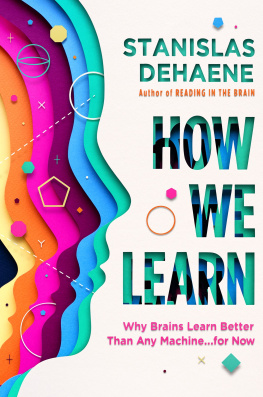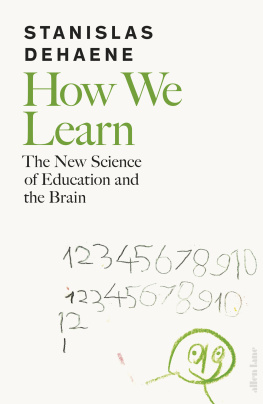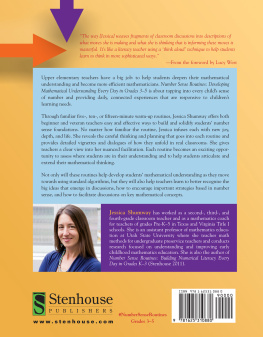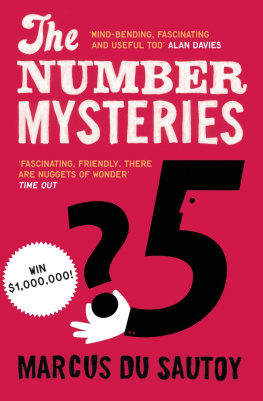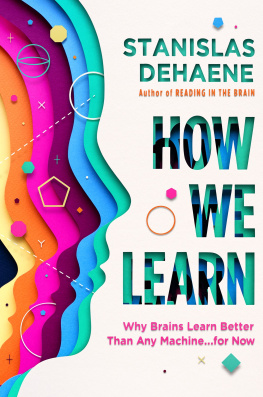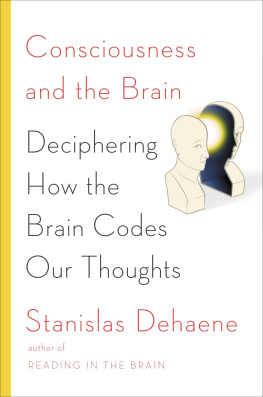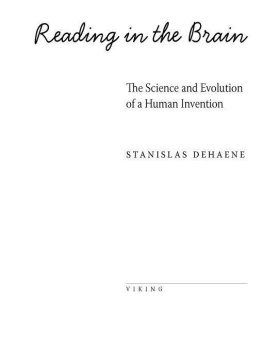THE NUMBER SENSE
The Number Sense
HOW THE MIND CREATES MATHEMATICS
Revised and Updated Edition
Stanislas Dehaene


Published in the United States of America by Oxford University Press, Inc.,
198 Madison Avenue, New York, NY, 10016
United States of America
Oxford University Press, Inc., publishes works that further Oxford Universitys
objective of excellence in research, scholarship, and education
Oxford is a registered trade mark of Oxford University Press
in the UK and in certain other countries
Copyright Stanislas Dehaene, 2011, 1997
All rights reserved. No part of this publication may be reproduced, stored in a retrieval system,
or transmitted, in any form or by any means, without the prior permission in writing of
Oxford University Press, Inc., or as expressly permitted by law, by licence, or under terms agreed
with the appropriate reproduction rights organization. Inquiries concerning reproduction outside
the scope of the above should be sent to the Rights Department, Oxford University Press, Inc.,
at the address above
You must not circulate this work in any other form and you must impose this same condition on any acquirer
__________________________________________
Library of Congress Cataloging-in-Publication Data
Dehaene, Stanislas.
The number sense: how the mind creates mathematics/Stanislas Dehaene.Rev. and updated ed.
p. cm.
Includes bibliographical references and index.
ISBN 978-0-19-975387-1 (pbk.)
1. Number concept. 2. MathematicsStudy and teachingPsychological aspects.
3. Mathematical ability. I. Title.
QA141.D44 2011
510.19dc22
2010042703
ISBN 978-0-19-975387-1
_____________________________________
1 2 3 4 5 6 7 8 9
Typeset in Garamond Premier Pro
Printed on acid-free paper
Printed in the United States of America
To Ghislaine, Oliver, David, and Guillaume
Contents
Preface to the Second Edition
A SCIENTIFIC BOOK is an unintentional time capsule. It has no sell-by date, which often means that readers will evaluate its theories, facts, and evidence, many years after publication, and do so with the omniscience of hindsight. The Number Sense, a book I wrote fifteen years ago, in my late twenties, is no exception to this rule.
I was lucky to start work on The Number Sense in the early 1990s, at a time when number research was in its infancy. A handful of laboratories had only just begun to scratch the surface of the field. Some focused on how infants perceived sets of objects. Others specialized in the way schoolchildren learn their multiplication tables, or studied the bizarre behavior of patients suffering from brain lesions that disrupted calculation. Finally, some, like me, made the first forays into brain imaging research to find out which brain areas lit up when students were asked a simple arithmetic question, like, is 6 larger than 5? Only a few of us, at the time, could see how all these studies would one day be pulled together into a single field, mathematical cognition, with multifaceted techniques all aimed at answering Warren McCullochs stimulating query:
What is a number, that a man may know it, and a man, that he may know a number?
The Number Sense was written with this single goal in mind: to assemble all the available facts on how the brain does elementary arithmetic, and prove that a new and promising field of research, ripe with empirical findings, was dawning. I also hoped that it might, perhaps, shed light on ancient philosophical disputes that questioned the very nature of mathematics. During the three years that it took me to put together all the different lines of research in the field, my enthusiasm increased as I realized how all the pieces of this complex puzzle fitted together into a coherent whole. Animal research on number pointed to an age-old competence for processing approximate quantities. This number sense, which is also present in infants, gave humans the intuition of number. Cultural inventions, such as the abacus or Arabic numerals, then transformed it into our fully-fledged capacity for symbolic mathematics. It was therefore obvious that a careful look at the brain structures for the number sense could shed much light on our understanding of mathematics. It provided a clear view of how evolution had proceeded, and reconnected our human abilities for mathematics to the way monkeys and even rats and pigeons brains represent numbers.
Since this book was written, some fifteen years ago, a flurry of innovative research has given this area a stronger impetus that I ever imagined. Mathematical cognition is now a well-established domain in cognitive science, and is no longer centered exclusively on the concept of number and its origins but has expanded into the related domains of algebra and geometry. Several research topics that were merely outlined in The Number Sense have become fully-fledged areas of research: number sense in animals, brain imaging of numerical computations, the nature of the impairment in children with mathematical difficulties ... One of the most exciting breakthroughs has been the discovery of single neurons that code for number in the monkey brain, at a precise site in the parietal lobe that appears to be a plausible homolog of the human area that activates when we calculate. Another rapidly developing area has to do with the application of this knowledge to education: we are beginning to understand how schooling develops the understanding of exact number and arithmetic, and how children who are at risk of developing dyscalculia can be helped with very simple games and software.
When I reread the first edition of this book, I was pleased to see that all of these ideas were already germinating, albeit somewhat speculatively, fifteen years ago. Now that research findings have solidly grounded them, I am convinced that a new edition of The Number Sense is in order. To be sure, several excellent books had been published since 1997, among them Brian Butterworths Mathematical Brain (1999), Rafael Nez and George Lakoffs Where Mathematics Comes From (2000), and Jamie Campbells edited Handbook of Mathematical Cognition (2004). But none of them captures the full range of what we understand today about number and the brain.
I am grateful to my agents, Max and John Brockman, and to my editors, Abby Gross and Odile Jacob, for encouraging me to embark on this new version and for helping me to decide what form it should take. We quickly agreed that to rewrite the past would be awkward or even presumptuous. It seemed important to give the reader an appropriate sense of how the field came into being twenty years ago, what motivated our current hypotheses, and how experimental methods had evolved since then, either to flesh out our theories or, occasionally, but fortunately not too often, to refute them. Thus, we conceived a second edition that would leave the original untouched but would supplement it with new references and, above all, a long, new, final chapter outlining the most outstanding discoveries that have been made since the first edition appeared. Selecting the findings that belonged in this chapter was an arduous task, since the field has literally exploded in the last fifteen years. Indeed, there are now hundreds of scientific findings that would have been relevant. Nevertheless, I decided to stick to a small list of surprising facts that, I believe, illuminate what arithmetic is at the brain level, and therefore how we should teach it.
Next page

